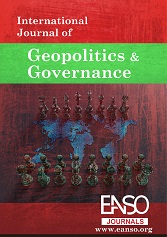The Current Conflict in Sudan and the Quest for a Final Solution for the People of Nuba Mountains
Abstract
The current conflict in the Nuba Mountains, which started immediately after the secession of South Sudan in 2011, is a result of the cumulative grievances shared by the people of African descent, generally referred to as people of the marginalized areas in Sudan. The policies pursued by the political elite in Sudan after the country attained its independence from Britain in 1956 were the main causes of the first and second civil wars. The people of the Nuba Mountains joined the Movement (SPLA/M) because of its national agenda, as crafted by the late John Garang in 1983, with the legitimate expectation that through armed struggle they would achieve their freedom. However, the peace processes that resulted in the signing of the Comprehensive Peace Agreement (CPA) did not address such a desire. This led to the resumption of armed struggle based on the same principles as enshrined in the SPLM’s Manifesto of 1983. But in as much as creating New Sudan as the basis for a final solution would be in conflict with the prevailing system of beliefs in the country there will be a need for an alternative option that would satisfy the desire for freedom of the people of Nuba Mountains. Generally, the purpose of this article is to provide a better understanding of the nature of the current conflict in the Nuba Mountains and how it should be resolved
Downloads
References
Adam, M. I. 2015. ‘The Dilemma of the Nuba’, in Samuel Totten and Amanda F. Grzyb, (Eds.), CONFLICT IN THE NUBA MOUNTAINS: From Genocide by Attrition to the Contemporary Crisis in Sudan. New York: Routledge, pp. 36-42.
Alier, A. 1973. ‘The Southern Sudan Question’, in Dunstan M. Wai, (Ed.). The Southern Sudan: The Problem of National Integration. New York: Routledge, pp. 11-27.
Comprehensive Peace Agreement (CPA), 2005
De Waal, A. 2015. ‘The Nuba Mountains, Sudan’, in Samuel Totten and Amanda F. Grzyb, (Eds.), CONFLICT IN THE NUBA MOUNTAINS: From Genocide by Attrition to the Contemporary Crisis in Sudan. New York: Routledge, 67-88.
EL Hassan, I. S. 2008., ‘Managing the Process of Conflict Resolution in the Sudan’, in Paul Tiyambe Zeleza & Alfred Nhema, (Eds.), THE RESOLUTION OF AFRICAN CONFLICTS: The Management of Conflict Resolution & Post-Conflict Reconstruction. The Ridges Athens: Ohio University Press, 106-117.
Garang, J. 1972. ‘Letter to Gen. Joseph Lagu’.
Jok, J. M. 2015. ‘Sudan’s Comprehensive Peace Agreement and how the Nuba Mountains were left out’, in Samuel Totten and Amanda F. Grzyb (Eds.) CONFLICT IN THE NUBA MOUNTAINS: From Genocide by Attrition to the Contemporary Crisis in Sudan. New York: Routledge, pp. 149-162.
Khalid, M. 2015. THE PARADOX OF TWO SUDANS: The CPA and the Road to Partition. Trenton: AFRICA WORLD PRESS.
Komey, G. K. 2015. ‘The Nuba Plight: An Account of People Facing Perpetual Violence and Institutionalized Insecurity’, in Samuel Totten and Amanda F. Grzyb (Eds.), CONFLICT IN THE NUBA MOUNTAINS: From Genocide by Attrition to the Contemporary Crisis in Sudan. New York: Routledge, 11-35.
Kuperman, A. J. 2016. ‘Conflict in the Nuba Mountains: From Genocide by Attrition to the Contemporary Crisis in Sudan’. IAGS Genocide Studies and Prevention: An International Journal, vol. 10, issue 2. Accessed web: https://digitalcommons.usf.ed/vol/10/issue2/11
Russell, P. and McCall, S. 1973. ‘Can Secession be Justified?’. In Dunstan M. Wai (Ed.), The Southern Sudan: The Problem of National Integration. New York: Routledge, pp. 93-121.
SPLM Manifesto. 1983.
SPLM Strategic Framework for War-To-Peace Transition, August 2004
Suliman, M. 1999. ‘The Nuba Mountains of Sudan: Resource access, violent conflict, and identity’. In Daniel Buckles (Ed.). Cultivating Peace: Conflict and Collaboration in Natural Resource Management. Ottawa: International Development Research Centre, pp. 205-220
Tinsley, R. 2015. ‘Who Will Remember the Nubans? The International Community’s Response to the Nuba Mountains Crisis, 2005- Present’, in Samuel Totten and Amanda F. Grzyb (Eds.), CONFLICT IN THE NUBA MOUNTAINS: From Genocide by Attrition to the Contemporary Crisis in Sudan. New York: Routledge, 209-244.
Totten, S. 2015. ‘The Problem of Impunity: A signal that Crimes Against Humanity and/or Genocide Are Forgivable?’, in Samuel Totten and Amanda F. Grzyb (Eds.), CONFLICT IN THE NUBA MOUNTAINS: From Genocide by Attrition to the Contemporary Crisis in Sudan. New York: Routledge, 112-145.
Waihenya, W. 2010. THE MEDIATOR: Gen. Lazaro Sumbeiywo and the Southern Sudan Peace Process. Nairobi: East African Educational Publishers.
Wendt, A. 2003. ‘Why a World State is Inevitable’. European Journal of International Relations, 9(4): 491-542.
Young, J. 2015. ‘Southern Kordofan Elections, May 2011’, in Samuel Totten and Amanda F. Grzyb (Eds.). CONFLICT IN THE NUBA MOUNTAINS: From Genocide by Attrition to the Contemporary Crisis in Sudan. New York: Routledge, 163-177.
Copyright (c) 2025 Ayuel Monyluak Aluou

This work is licensed under a Creative Commons Attribution 4.0 International License.




























